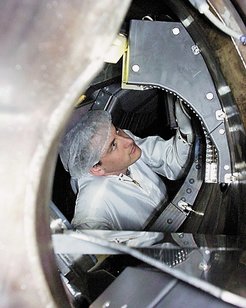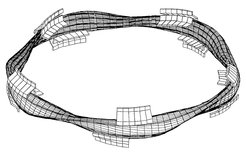Successful divertor operation in Wendelstein 7-AS
First divertor in a Wendelstein stellarator / preparation for Wendelstein 7-X

With the new component, which ensures that the plasma is not contaminated, it is possible to produce plasmas with good confinement properties and for long periods high densities hitherto unattainable – densities even exceeding the target for a power plant. As required, the thermal insulation of the plasma – the energy confinement time – increases with increasing density, while the confinement time for particles and impurities decreases. Undesirable deposition of impurities in the plasma is thus prevented; full density control and quasi-stationary operation are thus made possible.
IPP is the only institute in the world operating the two major types of device – the tokamak and the stellarator – parallel to one another. One of the crucial questions of equal concern to both types is the plasma purity attainable. Tokamaks were relieved of this problem in 1982 by the ASDEX device at IPP: An auxiliary magnetic field – the divertor – directed the boundary layer of the plasma to specially equipped collector plates at the bottom of the plasma vessel, where the plasma particles were neutralised and pumped off together with impurities. This is also how the "ash" of the fusion process – the helium thereby produced – is to be removed in a future power plant.

Wendelstein 7-AS was the first major stellarator to be equipped with a divertor. Unlike that of the tokamak, the plasma edge of a stellarator splits into individual bulges without further intervention – in keeping with the symmetry of the magnetic field. These "islands" are lined up like a string of pearls around the cross-section of the plasma and direct energy and particles to limited sections of the vessel wall. Protecting these areas – as in the divertor tokamak – with collector plates allows the impinging particles to be removed from the plasma together with impurities.
The results of the first series of experiments show that the first divertor in a Wendelstein stellarator has proved to be excellent for impurity and density control. The physical details are now to be clarified in further experiments. The information gained is of particular importance for Wendelstein 7-X, the follow-up experiment now being built at the Greifswald Branch of IPP.
Isabella Milch

